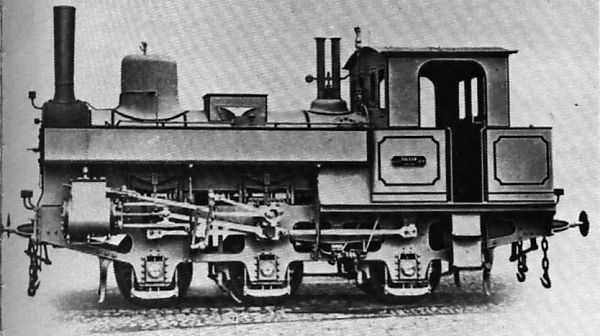Updated: 8 June 2005


Updated: 8 June 2005 |  
|
Friction-drive locomotives are rare, probably because having one frictional interface of doubtful dependability, between wheel and rail, is quite enough uncertainty for most people. Adding an extra one could be regarded as looking for trouble. Some of the friction-drive locomotives in the Museum, the Fontaine and the Holman, have not enhanced the reputation of the type; the first was wholly misguided and the second appears to have been of more interest to the criminologist than the engineer.
"FASOLT" A FRICTION-DRIVE LOCOMOTIVE: 1876.
This very rare, in fact unique, beast appears to be an honest if slightly misguided piece of engineering.
 | Left: The friction-drive engine "Fasolt". It was designated type D7, No 451
The aim here was the same as that of geared locomotives- to make a slow locomotive relatively powerful by operating the cylinders at a faster speed (giving more power for the same boiler pressure) than the driving wheels, there being a practical limit to how small the driving wheels could be made. |
To this end the cylinders drove three coupled crankshafts placed above the driving wheels; these crankshafts carried small friction rollers that contacted the top of the driving wheel tyres. A system of springs pressed the friction rollers onto the wheels, and were adjustable so the vertical force could actually be greater than the adhesion weight on the track. The friction rollers could be lifted clear of the wheels if it became necessary to tow the locomotive.
The reduction ratio is unknown, but working from the picture above, and estimating the size of the friction rollers, it appears to be about 1:3. The design speed was only 10 km/hr.
Information is scanty but it appears that the friction mechanism gave trouble, though whether by slipping or in some more subtle way is not clear. The locomotive was later rebuilt to a more conventional form by removing all but the central upper crankshaft and coupling it with rods to the wheel beneath. This in turn was coupled to the other wheels by conventional coupling rods. In 1906 the locomotive was still in existence, as No 2044, but after that its fate is unknown.
THE GUINNESS LOCOMOTIVES
Astonishingly, the locomotive above was not the only frictional drive system produced with serious intent. The Guinness brewery in Dublin, Ireland, made extensive use of narrow-gauge locomotives of only 1ft 10in gauge. The tiny engines could also be used on the broad gauge (5ft 3in) by mounting them on what was called a "haulage truck" much wider than the locomotive. This remarkable piece of engineering was not only a friction drive system, but also intended for gauge change, and worked successfully for many years. See The Oddest Locomotive where another locomotive was modified to work on a wider gauge, but with drive by rods.



